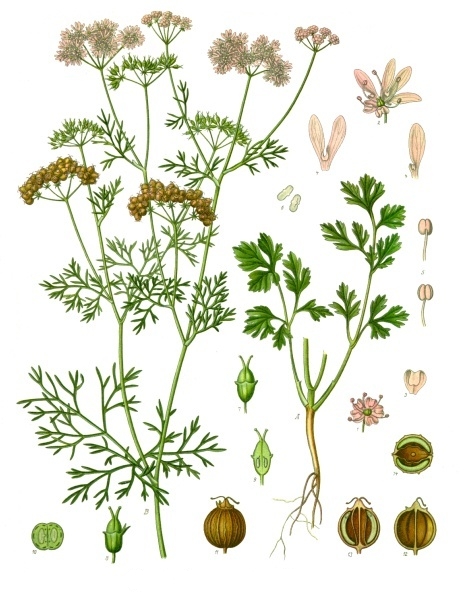Scientific Name: Coriandrum sativum
Other Names: Coriander, Cilantro (Spanish for "coriander"), Chinese Parsley
Description
Coriander, also known as cilantro, is an edible annual herb of the carrot or parsley family (Apiaceae) native to regions in southern Europe, North Africa, and southwestern Asia.The leaves at the base of the plant are lobed, with jagged edges at the tips, and look somewhat like parsley leaves. Leaves on the flowering stems, which grow higher than those at the base, are thin and feathery or "fern-like." The flowers are white or pale pink and are asymmetrical, growing in an umbel formation with the petals that point away from the center of the umbel longer (5–6 mm) than those pointing towards it (1–3 mm). The coriander fruit, which is often referred to as its "seed" is a dry schizocarp 3–5 mm in diameter.
Culinary Uses
Coriander leaves are used in Mexican cuisine in guacamole, salsa, and as a garnish. In Southeast Asian cooking, they are used to flavor meats, soups, and salads. The mature fruits/seeds, which are dried and have a spicy-sweet taste, are used to flavor sausages, stews, cakes, and sweetbreads in European and Middle Eastern dishes. They are also used to disguise the taste of some medicines in order to make the medicines more palatable.
Medicinal Uses and Chemistry
Coriander essential oil has antifungal and antimicrobial properties. Its main chemical component is linalool (58.22%), second most common is geraniol (17.87%), and the third most common is neryl acetate (12.22%). In smaller amounts, it contains: n-decanal (2.53%), dodecanal (2.35%), camphor (2.15%), 2E-decanol (1.32%), borneol (1.19%), and 2E-dodecanol (0.95%).
Pictures
Coriander flowers
Coriander leaves
Coriander fruits / seeds
LINKS FOR MORE INFORMATION:
Floridata
Missouri Botanical Garden
PLANTS Profile
Prevalence of cilantro (Coriandrum sativum) disliking among different ethnocultural groups
[PDF] Antifungal Activity, Toxicity and Chemical Composition . . .


No comments:
Post a Comment